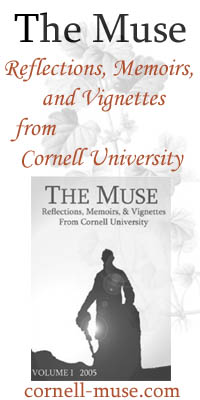David Harris: A Continued Conversation
In the second part of our interview with Cornell's interim provost, David Harris, we were able to explore one of his area's of expertise: diversity and its meanings in higher education. As a school with agriculture studies and philosophy majors, country bumpkins and city slickers, diversity and its many meanings is seemingly always on the minds of Cornell students, faculty, and alumni, but Harris approaches the issues with a more scholarly bent. Harris has previously written on the need to move beyond affirmative action as well as the nature of mixed-race relationships.
As the interview was conducted over email, we didn't actually get a chance to sit down with Harris. But this is what he would look like if we did:

The interview went well, but as Cornell partisans, we were ultimately disappointed with his answer to the final question.
When you assume the position of interim provost in August, you will become Cornell’s first non-white provost. How important is that to you, personally? How important of an occasion do you think that is to Cornell, a school with an egalitarian bent aiming to instruct “any person”?
I think it is special, but I hope that people do not forget that there remain tremendous inconsistencies between the racial, ethnic, and gender compositions of birth cohorts, and the compositions of the senior leadership of elite universities and top companies. There are myriad factors across the life course that account for differences in life chances. I feel fortunate to be the first black provost at Cornell. I would be truly happy if there were not racial disparities in life chances, from infant mortality rates, to incarceration rates, to life expectancies. Sorry to be a downer, but you did ask a quantitative inequality scholar about the significance of a single event.
Four of Cornell’s Ivy League peers – Harvard, Princeton, Penn, and Brown – all currently have female presidents, and one – Brown – currently has a black female as president. In your mind, how important it to have a female or a racial-minority in such a visible position as provost or president?
I think it is important, but it has to be the right person. Again, I think that we can be too focused on the demographic characteristics of the few people at the top of the organization. It is more difficult and more important to ascertain whether the organization is a place where all students and employees achieve to their full potential.
Cornell has historically struggled to enroll under-represented minorities relative to its peer schools. Why do you think this is? Is it due to Ithaca's location? The history of racial tension on campus?
I think that there are a number of factors. We are working very hard with admissions and others across campus to identify and address the factors that lead underrepresented minorities to apply to and select Cornell at lower rates than we would like.
Your work with the Diversity Council suggests that Cornell is moving away from the "Diversity Arches" approach and toward more substantive ways of talking through differences. Would you agree that your approach to diversity is in a slightly different vein than what has been pursued at Cornell before, and how would you describe it?
I think that our diversity approach is evolving. I encourage everyone to review our diversity website. It identifies goals and existing programs, provides news links and information about upcoming events, shares reports from across campus, and offers extensive data for a range of outcomes.
Every year it seems that student debates bubbles up over program houses on campus – particularly the culturally themed houses, and especially in regards to the living assignments for first-time freshmen. Do you agree with these policies, and if not, how would Cornell’s residential experience be organized in a world with limitless resources?
Cornell has taken a strong position that we are not going to reopen the program house debate until after West Campus is complete. I think that I’ll defer to the policy.
Self-segregation by race, socioeconomic-class, and academic interest often seems inevitable on large, diverse college campuses. Cornell’s former president, Jeff Lehman, has recently written on the need to look beyond diversity and study the extent to which integration occurs on college campuses. What are some of the things that Cornell can do to better integrate its campus?
I think you have to start by examining the premise of self segregation. President Lehman was right to argue that you get a very different sense of how segregated campus is if you follow individuals over time, as opposed to watching a particular context. The point is that many individuals who appear to be self segregating in one setting, spend most of their time in integrated settings and have diverse social networks.
We have a number of programs that encourage people to go beyond their comfort zones. The Tapestry of Possibilities and Breaking Bread are two examples (search on our diversity website for details). It is important to note that these programs focus on multiple dimensions of diversity, not just race and ethnicity.
You recently chaired a working group aimed at exploring programs that help to close the achievement gap across race and ethnicities on college campuses. Given Cornell’s responsibility as a land-grant institution, what more can the University be doing to mediate these performance differentials before students even apply for college?
We impact children through a range of outreach activities, such as Upward Bound and the Parenting in Context Initiative. We also impact educational opportunities through research, including the work of Steve Morgan, Maureen Waller, Kirabo Jackson, and Marianella Casasola. Last, and perhaps most importantly, we impact the lives of children through our teaching. The Social Inequality concentration is an excellent example of how we engage students who will go into a range of careers. These students will impact decisions in board rooms, court rooms, legislative bodies, and school boards around the world. We also hope that they will make personal decisions that are consistent with providing every child with an equal opportunity at success.
Your new book, an edited volume called The Colors of Poverty, argues that both social culture and policy structures interact and reinforce poverty in this country. Can the same be said of achievement in higher education?
To be blunt: Certainly. This was a major aim of the working group above, sponsored by the Teagle Foundation.
Your research has centered on the important question of multi-racial identity and experience in 21st century in America. For the first time in our nation’s history, we have the possibility to elect a black man of mixed-race heritage to the White House. Do you ever just like to stop people on the street and tell them, “See! I told you so!”?
No. We will have a major presidential candidate with parents from different racial groups, but he is almost always referred to as black. This speaks volumes about the difference between our rhetoric about racial progress and the reality of race in America. It is fascinating to me that Barack Obama—a man raised by his white mother and grandparents—would be the first “black” President of the United States. My point is not that it is right or wrong for Obama or us to identify him as black, but rather that this is quite different from the rhetoric about the emergence of multiracials.
Cornell beat your alma mater, Northwestern, in a varsity basketball game last year, but who would win in a Cornell-Northwestern football game? Keep in mind that the Wildcat’s have a measly all-time winning rate against Michigan of 18%, whereas the Big Red boasts a 66% wining percentage against the Wolverines…
I would have to see the game. Social scientists are notoriously bad at predictions.



